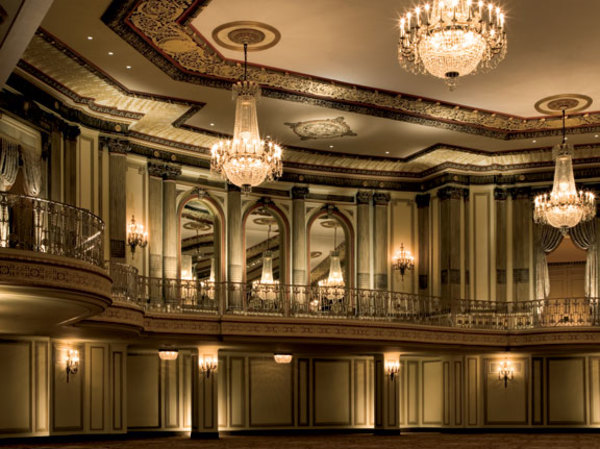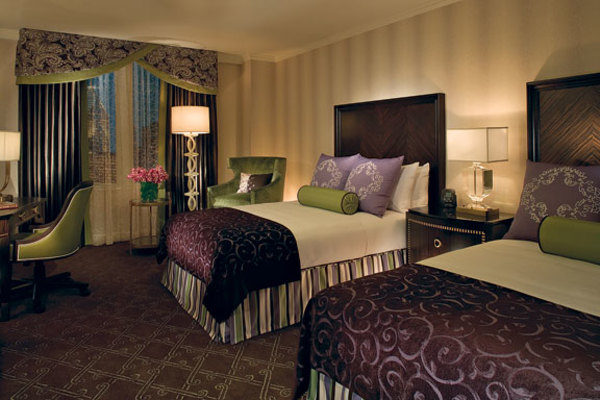
The Palmer House’s grand lobby boasts a remarkable ceiling. The two winged statues in the foreground were created by Louis Comfort Tiffany.
The Palmer House’s ceiling, resplendent with 21 panels of Greek mythological scenes that spring to life in rich paints and raised plaster, could rival that of the Sistine Chapel.
In fact, when the ceiling was restored a decade ago, it was at the hands of Liddo Lippe, the same master craftsman who repaired Michelangelo’s Vatican City masterpiece. Lippe worked flat on his back, raised on scaffolding, throughout the night so as not to disturb the guests. “We kind of made a show of him,” says Ken Price, the Palmer House’s director of public relations. “We’d roll out the scaffolding every evening around 9 and play Mozart while he worked on the ceiling.”
The ceiling is but one of many grand flourishes throughout the hotel, which was built by developer Potter Palmer in the French Empire style as a wedding present for his 21-year-old bride, Bertha Honoré. It opened on September 26, 1871, just 12 days before the Great Chicago Fire, which it did not escape.

Chandeliers in the Grand and State Ballrooms are 9′ tall, and had to be hung from specially designed dolleys during work to restore them—a project that included, among other things, removing and cleaning the fixtures’ 80,000 crystals.
Determined to rebuild, Potter immediately commissioned a new hotel, requesting that it be fireproof. The visionary building, made essentially of cement, was completed in 18 months’ time, and funded by a $1.7 million personal loan. Palmer worried about lighting the new hotel with candles, so he started looking for a better way. Legend has it that after hearing of a young inventor in Menlo Park, New Jersey, Potter became the first to install Edison’s creation—the light bulb—in a public building.
The new incarnation of the Palmer House quickly became known as the most elegant hotel in post-fire Chicago, and was so popular that in 1923 it was significantly enlarged. A new 25-story building, the third Palmer House, was designed by noted architectural firm Holabird & Roche (which later became Holabird & Root), and erected on the same site—the previous hotel was disassembled in two stages as the new one was erected, so the hotel never lost a day of business.
Modern and Historic
Today, that 25-story building has recently undergone a $178 million restoration that returned its original luster while integrating modern gathering places—restaurants, a spa, and a fitness club—into its historic fabric.

Tiffany touches throughout the hotel include an ethereal medallion on the lobby rail and artful, angelic hardware in the Empire Room that serves as a tieback for securing the latches of open casement windows.
Projects that sound straightforward—cleaning the chandeliers in the Grand and State Ballrooms—quickly turned into a logistical challenge, given that the chandeliers in question are 9′ tall and weigh more than a ton. “Because of their sheer size, they couldn’t be taken off of the property,” explains Price. The solution, devised by lighting restoration company Lumenelle, Inc., was to set up workstations on the premises, where each giant fixture was disassembled, cleaned, repaired, and rewired. Mapping and cataloging the chandeliers’ 80,000 crystals so they could be returned to the exact same spot was a logistical tour de force. “People think it was just a cleaning, but these chandeliers were completely restored,” says Peter Janko, president of Lumenelle. “They were brought down and taken apart, with each piece—crystal and metal—individually cleaned. Then they got all new sockets and wires up to UL standards.”
Smaller chandeliers grace the Red Lacquer Room, a space whose sumptuous gilding and hand-carved friezes were painstakingly repaired. The Palmers themselves bought these Austrian chandeliers on a trip to Europe; they are festooned in crude garnets per an aristocratic custom of the time, decking out the lighting in semi-precious stones.
Touring the Palmer House, it seems that such visual and historical riches wait around every corner. Off of the Monroe Street entrance, visitors are greeted by a pair of enormous hand-forged bronze doors, each adorned with filigreed peacocks, their delicate heads nearly touching the door frame, and their elaborate tail feathers trailing down to the floor. The doors were designed by Louis Comfort Tiffany to front the C.D. Peacock jewelry store, a landmark Chicago business—the first incorporated in the city—that was located in the Palmer House for decades. Each door weighs more than half a ton. “I can’t even begin to tell you what they’re worth,” says Price, whose personal hotel stationery bears a stylized embossed gold peacock. “They’re priceless real estate art.”
Time Travels

Double rooms are outfitted in textiles that draw from the colors and architectural details of the hotel.
Then there’s the Empire Room, reached via a prominent staircase in the lobby and through a set of black French doors. Open them, and you’re transported to another era, one where performers like Judy Garland, Ella Fitzgerald, and Liberace entertained diners on a stage so close you could touch it. Frank Sinatra’s career kicked off here when he appeared onstage with Tommy Dorsey, so unknown at the time that he wasn’t even on the bill. This room, with its dramatic gold-tinged Ionic columns and gilded friezes, also has been meticulously restored. “The room was completely regilded,” says Price. “Teams of artisans and craftsmen—a virtual army of people—worked on it for nearly half a year to bring back its original grandeur, guided by original drawings and vintage photos.”
Today the Palmer House is the oldest U.S. hotel in continual operation—it celebrated its 140th anniversary in September—having remained open throughout all of its rebuilding and restoration projects. Yet despite its well-documented and storied history, the hotel managed to keep some secrets for decades. The two bronze winged statues gracing the lobby, for example, were thought for decades to have been done by Frederic Auguste Bartholdi, the Italian sculptor commissioned to build the Statue of Liberty, largely because of the masculine nature of their faces. In fact, the hotel discovered in the late 1940s that they were created by Louis Comfort Tiffany after then-owner Conrad Hilton commissioned a study of all of the artwork; they’re now known to be Tiffany’s largest statues, weighing more than a ton apiece. “The reason Tiffany became so famous in the Midwest is because of the Palmer family,” Price explains. “They gave him tremendous exposure.”
Thanks to Potter Palmer’s vision and determination, today we can all be exposed to the hotel’s many treasures.







